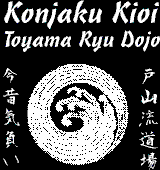 |
Toyama Ryu Batto Do Konjaku Kioi Dojo (Ancient and Modern Fighting Spirit Dojo) |
5980 66th St N Suite M St Petersburg FL 33709 Email: info@toyama-ryu.com Phone: 727-329-9679 |
|
Home
|
Tameshigiri 試し - Test Cutting
Tatami targets can be purchased at on-line at Nihonzashi. Preparing TargetsTatami omote is rolled into a target and soaked in water. Bamboo should be cut green within a day or so off harvesting. It can be keep longer if kept in water. You can also roll tatami omote around bamboo to provide a more challenging target. Tatami omote is rolled into a target and fastened with rubber bands or twine. Start by folding the tatami omote in two leaving the top edge about six inches from the bottom edge. This allows you to get the rolling started with a single layer. Crease the edge and begin rolling. Try to keep the target rolled as tightly as possible. If the center has as opening large enough to insert a finger, it is not tight enough. When the roll is complete, it is fastened with rubber bands or twine. We use six rubber bands to finish the target. Tatami targets are usually soaked overnight in a large barrel of water. A soak for as little as 2 hours will also work. It is not recommended that the targets be left in the water for over two days since the tatami will rot and become increasingly disgusting. We recommend a closed barrel to keep everything but the water and tatami. Dry tatami is quite buoyant and weight may have to be added to the barrel lid to keep it down when filled with water. A valve near the bottom of the barrel will make emptying the barrel easier. An alternative to barrels are flat storage containers that are long enough to hold the tatami lying down. A bath tub and cinder blocks can also be used in situations where no other alternatives are available. Target StandA standard cutting stand is 24 inches (2 shaku) tall 24 inches (2 shaku) wide, and 24 inches (2 shaku) deep. It has a 6” peg that is 7/8” in diameter. The peg needs to be replaceable since it is damaged by spiking and is often cut. The stand should be designed so that an errant cut does not hit any metal components are chip the blade. It should be fairly heavy to reduce the chance of tipping over. A stand made of cedar will tip too easily, but a stand made of oak should be stable enough to not require extra weights on the legs. Spiking Tatami TargetsThe tatami target should be held in both hands near the top of the target. Serious injury can result if the stand is missed and the hands are too low. Imagine spiking your hand on the stand instead of the target. The target is thrust down onto the spike/peg on the top of the cutting stand. The entire spike should be in the target with the target touching the top of the stand. The target can be seated further by rotating it back and forth while pushing it further onto the spike. If the cutting stand has a metal screw holding the spike, this should be positioned away from the cutter. The seam in the tatami should also be placed away from the cutter. If the peg becomes damaged or cut, it needs to be replaced or re-sharpened. This can be done with a dowel pointer or draw knife. During competitions it is important to always replace the spike/peg to assure that all competitors have the same height peg (cutting the peg is a disqualification). Some schools cut tatami targets without using a spike and simply set them on the stand. |
Copyright © 2006 by Konjaku Kioi Toyama Ryu Dojo, All rights reserved.
Samurai Swords
Iaito (Practice Swords)
Shinken (Cutting Swords)
Wakizashi (Short Swords)
Tanto (Daggers)
Japanese Weapons
Maintenance
Uniforms
Sharpening
Sword Repair
Martial Arts
Dictionary Your Name in Japanese
Dojo Stories
Tatami Targets
